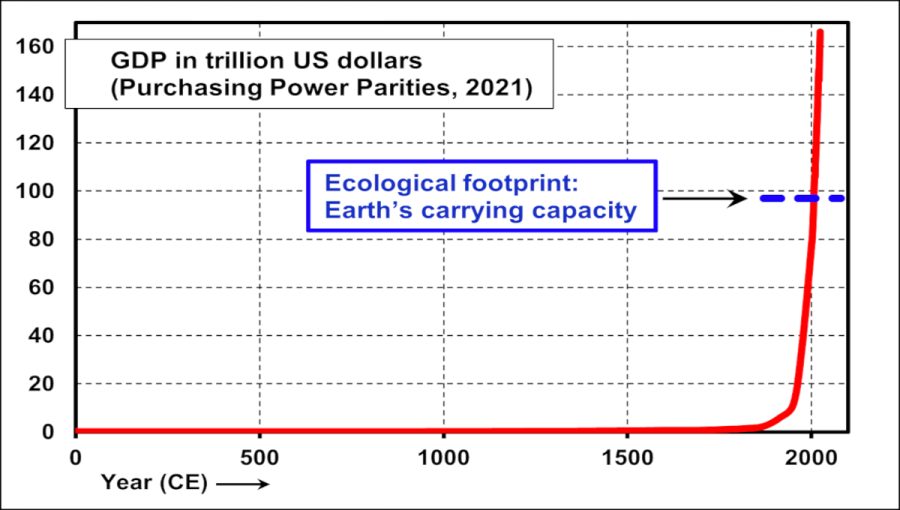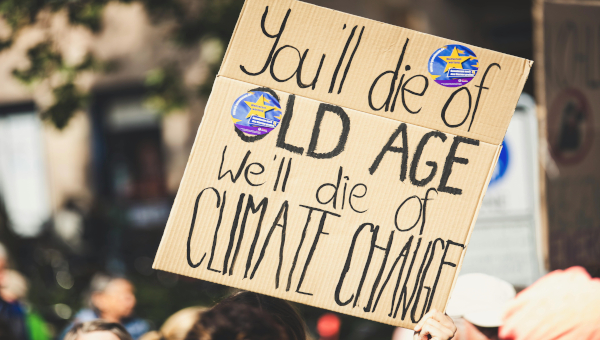COP-Out: The Military and Climate Change/Justice
The world situation is much worse than generally acknowledged. This December, the coinciding meetings of NATO and of the climate change Conference of the Parties (COP25) were barely reported, much less analyzed, even though the delegates held the fate of humanity in their hands. To some degree, both meetings are secret, and their unelected delegates are not accountable to the public. COP has met far from the ‘maddening crowd’ ever since the large protests at Copenhagen COP15. NATO provides credibility, flexibility, and anonymity in equal doses and shields member states from legal and political accountability. NATO policy is not to reveal which member state participated in a military operation.1 NATO countries refuse to sign the nuclear ban treaty and now legitimize a nuclear weapons first strike. To judge by the results delegates in both organizations chose to ignore both science and the human situation.

The military is the single largest institutional emitter of greenhouse gases, but its emissions are exempt under the Kyoto Protocol, a convenient accomplishment negotiated by Nobel Peace Prize recipient Al Gore. In its practice of protecting property and oil installations, in its mandate to kill, and in securitizing borders, the military is also the single largest contributor to climate injustice. The many interconnections between militarization and climate change continue to be overlooked at all COP meetings, by Intergovernmental Panel on Climate Change (IPCC) scientists, by green new deals, and by climate and anti-war movements. It is hard to understand the silence: anthropogenic climate change and global militarization continue to be driven by political decisions within government and financial institutions. The military’s attribution of violence to victims of climate disasters is used to justify permanent war, militarized borders, global surveillance, and strategies of pacification.
CO2 Emissions Increasing
Despite the October 2018 warning about the climate emergency, all major greenhouse gases increased this past year, and after twenty-five years of climate meetings, there are still no mandatory caps on emissions in any sector. There are no enforceable measures to immediately stop anything. The current concentration of CO2 is at least 407.8 ppm and is far above the maximum safe level of 350 ppm which is the estimated turning point to an ice-free world. The carbon budget is an economic fiction that grossly misleads about climate system dynamics as it omits amplifying feedbacks and the paleoclimate record of sudden shifts. The climate budget erroneously assumes a slow, steady, stoppable global warming trajectory.
Profound Earth system changes are already taking place at a time of unprecedented immiseration across the world. There are 70 million refugees crossing borders and 20 million people a year internally displaced due to climate disasters. The number of walled, securitized borders increased from fifteen at the end of the Cold War to the current seventy-seven. Newly released figures indicate that US wars since 9/11 have killed 801,000, with the total figure likely to reach 3.1 million or more. And despite the purported goal of the 2010 Cancun COP to fund $100-billion for loss and damages by 2020 and $100-billion a year thereafter, only a paltry amount has been collected and this last meeting again simply postponed dealing with climate debt.
As greenhouse gas concentration and global temperature rise at an ever increasing rate, climate centres predict temperatures far higher than the 1.5⁰C target (which is hardly ‘safe’). The current global average surface temperature of less than 1⁰C increase has already led to hundreds of thousands of human fatalities each year due to heat waves and extreme weather events (2009 report). Less than 1⁰C increase has caused severe droughts and more intense tropical storms, flooding, forest fires, melting permafrost, changes in the jet stream and Atlantic circulation, ocean acidification, sea level rise, salt water incursion into major agricultural areas like the Nile and Mekong deltas, ocean absorption of heat and CO2 that now affects the amount of oxygen in the ocean.
The military bases its role in climate change on two premises: that the military is the global institution best equipped to respond to climate disasters, and that the military need to provide security because climate victims will inevitably respond violently to climate-related crises. There is ample evidence of the exact opposite.
Military End-Times Projects
It can happen here: within minutes, weapons could end life on Earth. Daniel Ellsberg reveals that the Manhattan Project (1942 – 1946) nuclear physicists chose to gamble with the possibility that the Trinity nuclear bomb test could have ignited the Earth’s atmosphere and ocean and extinguish all life. Ellsberg quotes sources stating that not even Hitler chose to have this much power.2 Since the end of WWII, the major military powers, especially driven by NATO, constructed an alternative world of immense, sadistic destruction. The Revolution in Military Affairs (RMA) emerged with the end of the Cold War. Its mandate was to achieve full-spectrum dominance: “the technological control of land, sea, air, and space, the ‘human terrain’, the electromagnetic spectrum, and the ability to rapidly translate global power projection into decisive force in any circumstance and environment” within minutes or hours.3
Weapons Systems Emissions: Barry Sanders,4 researching the environmental costs of militarism, writes that national tallies of greenhouse gas emissions are not included in national energy-use records. The Pentagon wars in Iraq and Afghanistan; its secret operations in Pakistan; its equipment “on more than 1000 US bases around the world, its 6,000 facilities in the US; all NATO operations; its aircraft carriers, jet aircraft, weapons testing, training and sales will not be counted against US greenhouse gas limits or included in any count… Also excluded are its weapons testing and all multilateral operations such as the giant US commanded NATO military alliance and AFRICOM, ‘peacekeeping’ and ‘humanitarian relief’.”5 The military consumes one quarter of the worlds’ jet fuel.
For perspective, on the first night of Shock and Awe in 2003, Sanders notes that “1,700 aircraft – bombers, fighters, and other warships – flew roughly 1,400 strike sorties on critical targets, and fired 504 cruise missiles, directly into the heart of Baghdad.” The B-52H Bomber holds 47,975 gallons of fuel and still requires mid-air refueling. The F-15 uses 25 gallons/minute or 1580 gallons/hour. The B-52 Stratocruiser with 8 jet engines uses roughly 3334 gallons/hour. Added to this are the refueling tankers accompanying fighter jets, loaded with between 150,000 lbs and 210,000 lbs of transfer fuel. The battleship USS Independence consumes 100,000 gallons of fuel/day. Targeted bombing of highly volatile strategic sites like fuel and weapons depots, power plants, fertilizer plants, and chemical plants, releases CO2 and other toxins into the atmosphere.
Sanders found that most of the information about troop deployments, military bases, fatalities, and energy consumption is “deliberately withheld from the general public, made intentionally obscure, folded inside arcane reports, or hidden on hard-to-find governmental websites by the Department of Defense, or the Pentagon, or the General Accounting Office.” Sanders writes that there are several major factors that make it impossible to uncover actual numbers. The Department of Defence provides no official accounting for the amount of oil the military consumes in garrisons and bases abroad. And none of the official figures include fuel that the military obtains at no cost overseas or the fuel that is used by independent contractors. The Pentagon employs a different accounting practice for the fuel from its different branches, and high heat-trapping bunker fuel remains off the record.
Military Electronic Emissions: These numbers are only one part of military greenhouse gas emissions. Requiring immense electricity are military data centres for surveillance, cyberwarfare, border control and securitization. As yet, the main proposed alternative source of energy has been an eventual switch to biofuels which would require immense deforestation and prioritizing fuel over food. Life-cycle analysis of electronic components includes the mining of metals and minerals and Kyoto-exempt transportation of materials for the manufacturing process.
There are now seventy-seven militarized and electronically securitized borders in the world, built to keep out terrorists and economic and climate refugees. Relying on Israel’s border strategies and technology, borders are armed with drones, satellites, surveillance cameras, radar and electronic warfare. US Customs and Border Protection (CBP) has forty-eight offices worldwide to support homeland security operations. Todd Miller, in his book Empire of Borders, quotes from the US 9/11 Commission Report: “…the American homeland is the planet.”6 In 2014 the UN Security Council passed Resolution 2178 calling on member states to put border security systems in place for counterterrorism purposes. The UNSC thus mandates a global infrastructure requiring massive electricity in order to illegally obstruct human migration.
Wars Destroy Carbon Sinks: US wars defoliants and chemical weapons destroy extensive swaths of the forest and soil carbon sink in North Korea, Laos, Vietnam, Cambodia, and in the Middle East. An estimated 85 per cent of the ammunitions used by the US Army targets environments sheltering people.
Other Military Emissions: Military emissions include fuel used for reconstruction, especially the most energy-intensive production of steel and cement. The US 2003 carpet bombing of Iraqi infrastructure was immediately followed by government reconstruction contracts with the Halliburton and Bechtel corporations, with their close ties to the American state and military.
China, often depicted as a model of climate foresight because of its renewable energy sector, has constructed a vast fossil-fuel corridor stretching through Asia, Europe, and North Africa. A recent Guardian article cites a Pentagon report on a chain of Chinese military bases to be included in the project as well as a military presence in the Arctic Ocean.
Military Security/Climate Justice
Dave Webb, professor of engineering, contributes crucial information about the military/climate nexus.7 A newspaper report from February 2004 caught international attention: “Now the Pentagon tells Bush: climate change will destroy us… The US President has denied the existence of global warming. But a secret report predicts a looming catastrophe – a world riven with water wars, famine and anarchy.” Based on what became known as The Pentagon Report by Peter Schwartz and Doug Randall of the Global Business Network, much has been written about its timing and message. The Pentagon paid $100,000 for the Report which was commissioned by Andrew Marshall who had worked in the National Security Council, for the Rand Corporation, and in the Office of Net Assessment to form US military and political strategies. One interpretation is that The Report was proposing that the Department of Defense should be planning ‘no-regret (military) strategies’ for worst-case global warming-induced eventualities: “But a more dystopian reading [and quite prescient] would be that Schwartz and Randall are setting the ground rules for the US to start building a virtual wall around its national boundaries: restricting the movement of people into the country, developing technologies of political control, and preparing for increased threats from nuclear war.”
NATO, the US Navy, and the Pentagon have issued policy statements on the military role in climate change. The military defines climate change as a “threat multiplier.” In a presentation by former NATO Secretary General Anders Fogh Rasmussen, fifteen of the seventeen non-military issues that NATO is prepared to address are climate-related. Emily Gilbert’s article, “The Militarization of Climate Change”, focuses particularly on the polar regions. She writes that climate change has been identified as a top military concern, that “We should be worried.” The US Navy claims to have strategic interests in the Arctic. The race for global economic and military hegemony extends to the Arctic and Antarctic as warming opens up competition for sea lanes and resource extraction. In 2009, the US Department of the Navy released a 36-page document called Navy Arctic Roadmap. “The United States has broad and fundamental national security interests in the Arctic region and is prepared to operate either independently or in conjunction with other states to safeguard these interests… What the practical implementation of this policy means is the expanded penetration of the Arctic Circle by the US Navy’s submarine-launched ballistic missile (SLBM) third of the American nuclear triad…” The 2010 Pentagon Quadrennial Defense Review includes climate change as a military issue. In a memo made public on January 19th, 2016, the Pentagon affirmed that “climate change will be a constant consideration in how the Department of Defense goes about its war mission, acquisition programs, readiness plans, construction projects and security judgements… [including] a larger presence in the Arctic, where more land and sea are exposed as the polar ice caps melt.” Gilbert questions “whether there should indeed be a military at all.”

In Canada, former Prime Minister Stephen Harper withdrew government funding of the Canadian Foundation for Climate and Atmospheric Sciences, including Canada’s northernmost research station Polar Environment Atmospheric Research Laboratory (PEARL) in Nunavut. The informal network of university researchers was not able to secure the $1.5-million annual funding required to continue running the station all year round. PEARL is the biggest lab in Canada’s High Arctic and, one of the closest in the world to the North Pole. The federal government will instead fund the construction of six to eight new Arctic patrol ships, costing about $3.1-billion, to help reassert Canada’s sovereignty over the North.
‘Threat Multiplier’ and Climate Justice
The branches of the military define climate change as a “threat multiplier” in which all regions of the world will be besieged by masses of refugees. Again, from Dave Webb’s article: The Pentagon Report authors write that in the future, deaths from war, famine and weather-related disasters run into millions. There are riots and internal conflict in India, South Africa and Indonesia. Countries begin looking closely at their neighbours’ resources as they lose their ability to feed and care for their own populations… humans fight when they outstrip the carrying capacity of their natural environment. “Every time there is a choice between starving and raiding, humans raid.”
Betsy Hartmann, a professor of Development Studies, calls this the Degradation Narrative that says that anarchy and chaos are likely to ensue when natural disasters strike. “This way of looking at climate conflict first hit the big time in 2007, when in a remarkable chorus, the Atlantic Monthly, the United Nations Environment Program, the UN Security Council, and even UN Secretary General Ban Ki-Moon announced that the violence in Darfur was due to a combination of demographic pressures, resource scarcities and climate change.” Hartmann and others point out that the degradation narrative is incorrect and that it obscures the real causes of conflict. For example, “in real cases, researchers find, pastoralists engage in less conflict, not more, in times of droughts and environmental stress, strengthening common property regimes that govern water use.”8
The degradation narrative obscures state-sanctioned violence against the poor. It is not simply drought that threatens water supply, but water giveaways to Nestle, Coca Cola, the mining sector, tar sands and fracking, World Bank funding of large hydro dams, polluting military superfund sites, water diversions to water- and soil-depleting cash crops, and targeted military destruction of water infrastructure such as the US in Baghdad and Israel in Gaza. Attributing Syrian and Honduran violence to climate change ignores state-sanctioned land theft and severe cuts in government spending, often imposed by odious debt and IMF Structural Adjustment Programs, in these highly militarized, authoritarian states. Drought in the Amazon was partly caused by massive deforestation due to the agribusiness expansion into animal feed and biofuels. Water conflicts in themselves do not cause violence: 450 water agreements on international waters, and 145 water-related treaties, were signed between 1820 and 2007.9
Climate Emergency
Climate discourse and action generally focuses on one part of the whole, leaving out crucial information. Transition leaves out the possibility of “stop now.” The belief that 100 per cent renewables will solve the greenhouse gas problem omits the huge emitting sectors that will still be dependent on fossil fuels: the military, aviation, shipping, and the agro-industrial complex. Omitted in national emission statistical pie charts are externalities and life-cycle analyses, categories for high-emitting products like cement or natural gas and tar sands extraction, outsourced emissions, and exempt sector emissions.
These are strange times. Artificial intelligence, rocket science, data and informatics replace knowledge and wisdom in making life and death decisions. The cost of wars is priceless human life, but the profits are in trillions of dollars and in untraceable untaxed wealth. Daily life continues within this world of overwhelming, ominous threat. Wise words from two Dylans: “you know something’s happening but you don’t know what it is”; or knowing, so “Rage against the dying of the light.”
The problems are profoundly far-reaching and horrific, and urgent political action along these many fronts requires utmost cooperation, knowledge, and respect for the human world in the struggle for necessary revolutionary change. •
Endnotes
- Michael J. Glennon (2015). National Security and Double Government (New York: Oxford), pp. 100-101.
- Daniel Ellsberg. (2017). The Doomsday Machine (New York: Bloomsbury), pp. 278-283.
- Jeff Halper. (2015). War Against the People: Israel, the Palestinians and Global Pacification (London: Pluto), pp. 73-75.
- Barry Sanders. (2009). The Green Zone: The Environmental Costs of Militarism (Oakland: AK Press), pp. 40-59.
- Sara Flounders, “The Pentagon – the climate elephant.”
- Todd Miller. (2019). Empire of Borders: How the US is Exporting its Borders Around the World (London: Verso), p. 6.
- Dave Webb. “Thinking the Worst: The Pentagon Report” in David Cromwell and Mark Levene, eds. (2007). Surviving Climate Change: The Struggle to Avert Global Catastrophe (London: Pluto Press), pp. 59-81.
- Betsy Hartmann and Jean Selby “Time to drop the Climate War Talk.”
Betsy Hartmann discusses the degradation narrative in this paper: “Challenging the Militarization of Climate Change,” Plenary on Militarization and Security, Peace and Justice Studies Annual Conference, Anticipating Climate Disruption, Tufts University, October 6, 2012. - Mary Ann Manahan. “In Deep Water: confronting the climate and water crisis” in Nick Buxton and Ben Hayes. (2016). The Secure and the Dispossessed: How the Military and Corporations are Shaping a Climate-Changed World (London: Pluto Press), pp. 194-5.





